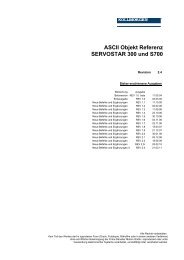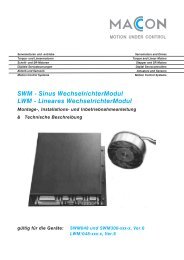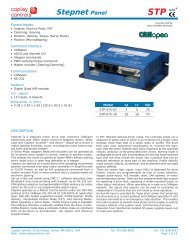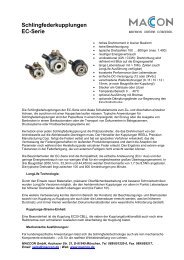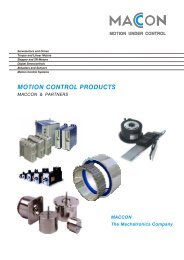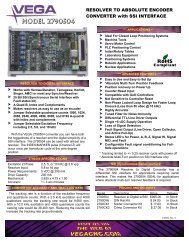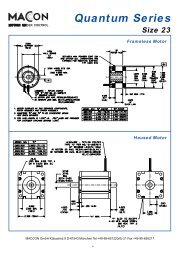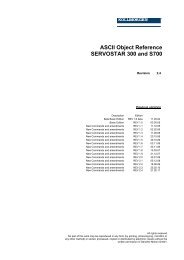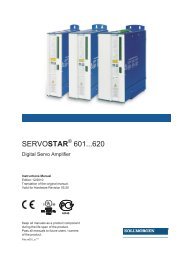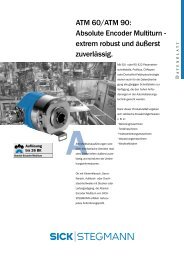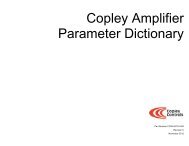CANopen Programmer's Manual - Maccon.de
CANopen Programmer's Manual - Maccon.de
CANopen Programmer's Manual - Maccon.de
You also want an ePaper? Increase the reach of your titles
YUMPU automatically turns print PDFs into web optimized ePapers that Google loves.
4: Control Loop Configuration <strong>CANopen</strong> Programmer’s <strong>Manual</strong><br />
The Position Loop<br />
Position Loop Diagram<br />
The <strong>CANopen</strong> master provi<strong>de</strong>s a target position to the amplifier’s internal trajectory generator. In<br />
turn the generator provi<strong>de</strong>s the position loop a position command and velocity and acceleration<br />
limit values. The position loop applies corrective gains in response to feedback to forward a<br />
velocity command to the velocity loop. The inputs to the position loop vary with different operating<br />
mo<strong>de</strong>s. The following diagram summarizes the position loop in position profile mo<strong>de</strong>.<br />
Target<br />
Position<br />
Limits:<br />
Max velocity<br />
Max accel<br />
Max <strong>de</strong>cel<br />
Abort <strong>de</strong>cel<br />
Trajectory<br />
Generator<br />
Profile Velocity<br />
Profile Acceleration<br />
Limited Position<br />
+<br />
Feedback<br />
-<br />
Position Loop<br />
Velocity Feed Forw ard (Vff)<br />
Acceleration Feed Forw ard (Aff)<br />
Position Proportional Gain (Pp)<br />
Velocity<br />
Command<br />
130 Copley Controls<br />
+<br />
+<br />
+<br />
Gain<br />
Multiplier<br />
from motor enco<strong>de</strong>r or resolver<br />
from optional position enco<strong>de</strong>r (on load)<br />
Trajectory Generator Inputs and Limits<br />
The inputs to the trajectory generator inclu<strong>de</strong> profile position, velocity, and acceleration values.<br />
They are accessed through different sets of mo<strong>de</strong>-specific objects as summarized below.<br />
Mo<strong>de</strong> Input Object Name/ID Description Page #<br />
Homing Homing Method / 0x6098 Defines the method to find the motor home position 184<br />
Profile<br />
Position<br />
Interpolated<br />
Position<br />
Homing Speeds / 0x6099 The sub-in<strong>de</strong>x objects of 0x6099 hold the two velocities<br />
(fast and slow) used when homing.<br />
Homing Acceleration / 0x609A Defines the acceleration used for all homing moves. 185<br />
Home Offset / 0x607C Used in homing mo<strong>de</strong> as an offset between the home<br />
sensor position and the zero position.<br />
Motion Profile Type / 0x6086 Selects the type of trajectory profile to use. Choices are<br />
trapezoidal, S-curve, and velocity.<br />
Target Position / 0x607A Destination position of the move. 202<br />
Profile Velocity / 0x6081 The velocity that the trajectory generator attempts to<br />
achieve when running in position profile mo<strong>de</strong>.<br />
Profile Acceleration / 0x6083 Acceleration that the trajectory generator attempts to<br />
achieve when running in position profile mo<strong>de</strong><br />
Profile Deceleration / 0x6084 Deceleration that the trajectory generator attempts to<br />
achieve at the end of a trapezoidal profile when running in<br />
position profile mo<strong>de</strong>.<br />
Trajectory Jerk Limit / 0x2121 Defines the maximum jerk (rate of change of acceleration)<br />
for use with S-curve profile moves.<br />
IP move segment command /<br />
0x2010<br />
Used to send PVT segment data and buffer commands<br />
when running in interpolated position mo<strong>de</strong>.<br />
185<br />
185<br />
205<br />
203<br />
204<br />
203<br />
202<br />
214




